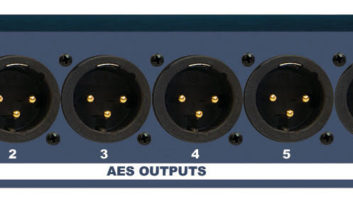There are fewer fully equipped service benches in the radio broadcast industry today, and doing things yourself is increasingly common. Here are some professional tips to simplify the job and ensure better results when you do your own repair work. They apply even if you are just looking inside a piece of equipment to see where the smoke might have leaked out.
It goes almost without saying that you need a clean well-lit area with plenty of power outlets. Poor lighting can easily cause you to misread the color on a wire or resistor. Visual inspection of malfunctioning gear can often reveal a problem even without extensive electronic testing.

Fig.1: Make registration marks with a liquid pen.

Fig. 2: Label connectors to avoid errors. When benching a piece of equipment, the first thing I do is use a marker pen to put “registration marks” on cabinet parts so they can be reassembled later without a question of what goes where. (This might not seem important if you did well on the “square peg and round hole” test when you were young; but if you didn’t this could be a lifesaver.) You can even take a digital photo and refer to it when reassembling the equipment. Sometimes it is important to also mark the exact position of hardware, as it may have been factory-aligned precisely.
I sometimes receive “basket case” equipment for repair. Someone had attempted a repair and then gave up, leaving many screws and other small parts behind on the service bench before throwing the dismembered equipment into a shipping box. Fortunately, I did well in the square peg/round hole test, and I have a huge assortment of new and used hardware. Yes, I save old screws, bolts and nuts to replace missing ones on equipment. You should too.
An electric screwdriver usually works well in disassembling equipment. Reassembly is different and will be discussed later.
In the meantime, use small cups to hold screws and other hardware so they don’t escape to the floor or elsewhere. Keep loose hardware in one place so it doesn’t get lost; I use plastic boxes from 3M Scotch brand electrical tape. Better yet, use several containers so you won’t confuse bolts and nuts from one module with hardware from another part of the equipment.
Once I have the equipment open/disassembled, I use compressed air to blow bugs and dirt out. Do this outdoors so grime does not get into your workshop area. A paintbrush works well to help loosen dirt so an air blast can blow it away. This is a two-handed operation.
Use a liquid pen to label everything you disconnect, including connectors, before you take anything apart. It is so much easier to go back to where it all started, especially if you are unexpectedly interrupted by a phone call and rush to a dead transmitter. The pen I use is the Ultra Fine Point SCA-UF by Pilot. Unlike other markers, it barely fades over the years.

Fig. 3: Mark wire color on board before removing wire. Mark words or abbreviations on circuit cards where wires might be removed, even temporarily. Short-term memory becomes a problem as you grow older, and this might save you a lot of trouble down the road.
You can never have too many tools on hand. I recommend a soldering iron rather than a soldering gun. An iron will stay warm for the entire job and will not have to be reheated each time you make a solder connection. I like to use a soldering station, which keeps the iron tip at a constant 700 degrees F. A wet sponge to wipe the iron tip on is an excellent choice, too.
Use a small sharp pair of wire cutters to trim ends off tie wraps. Leaving tails long is a good way to tear skin next time you or someone else is working in that area.
Do it right by resting one side of the cutter jaw on the side of the tie-wrap large end and then slice the tail as you squeeze. This action shaves the tail flush. If you are in a situation where tie wrap reliability is important, put a drop of Super Glue in the end.

Fig. 4: Cut tie wraps close to prevent future injury. Denatured alcohol and cotton swabs are my constant companions for cleaning. You should take pride in making repairs that keep a piece of equipment looking the way it did when it came out of the factory. Even if the equipment owner does not know you did a good job, at least you can be proud of your handiwork.
One valuable piece of bench gear is the Sencore AC Powerite. It is a 0 to 150 volt variable AC isolation transformer capable of handling 470 watts. The circuit breaker on the front is a handy on-off switch, so I don’t have to go looking for the power cord every time a component is replaced and the power needs to be turned back on for more testing. The Powerite allows me to start at zero and slowly bring voltage up to see if and when a problem occurs.
I also use it to determine how low the 120 volts can be reduced before power supply hum happens in audio. If power supply electrolytic capacitors are weak, that might happen quickly. Any good piece of electronic equipment should work fine down to 100 volts or even lower.
When reassembling equipment, I often use a jeweler’s screwdriver, sometimes called a precision screwdriver, to get the hardware started. The one shown was available at Radio Shack and now there is an updated version with a larger handle (part number 6400188).
I do not use an electric screwdriver at this point. Cross-threading a screw can have lasting consequences. The “feel” of how a screw is threading tells me when all is well. You don’t get that with an electric screwdriver. The skinny body of a jeweler’s screwdriver cannot normally provide enough torque to cause hardware problems.

Fig. 5: Use a jeweler’s screwdriver to start bolts. The good part is that you can turn chassis screws in quickly using this tool. Yes, they are smaller than a full-sized screwdriver, but you are not going to use one to tighten a bolt or screw. Just turn the hardware in with a loose fit. Waiting to “tighten” chassis screws until they are all in place is the right thing to do too. How many times have you tightened hardware and then had to loosen it because mechanical tolerances prevented inserting the remaining screws?
Sometimes working on equipment requires delicacy akin to surgery. A wide assortment of tools is a great asset here.
Document any changes you make to the equipment, ideally in the original equipment manual. I usually make notations in pencil so they can be modified again in the future.
Mark Persons, WØMH, is a Certified Professional Broadcast Engineer who has more than 45 years’ experience. His website iswww.mwpersons.com.
Share your suggestions for future topics. Email [email protected] with “Tech Tips” in the subject field.












